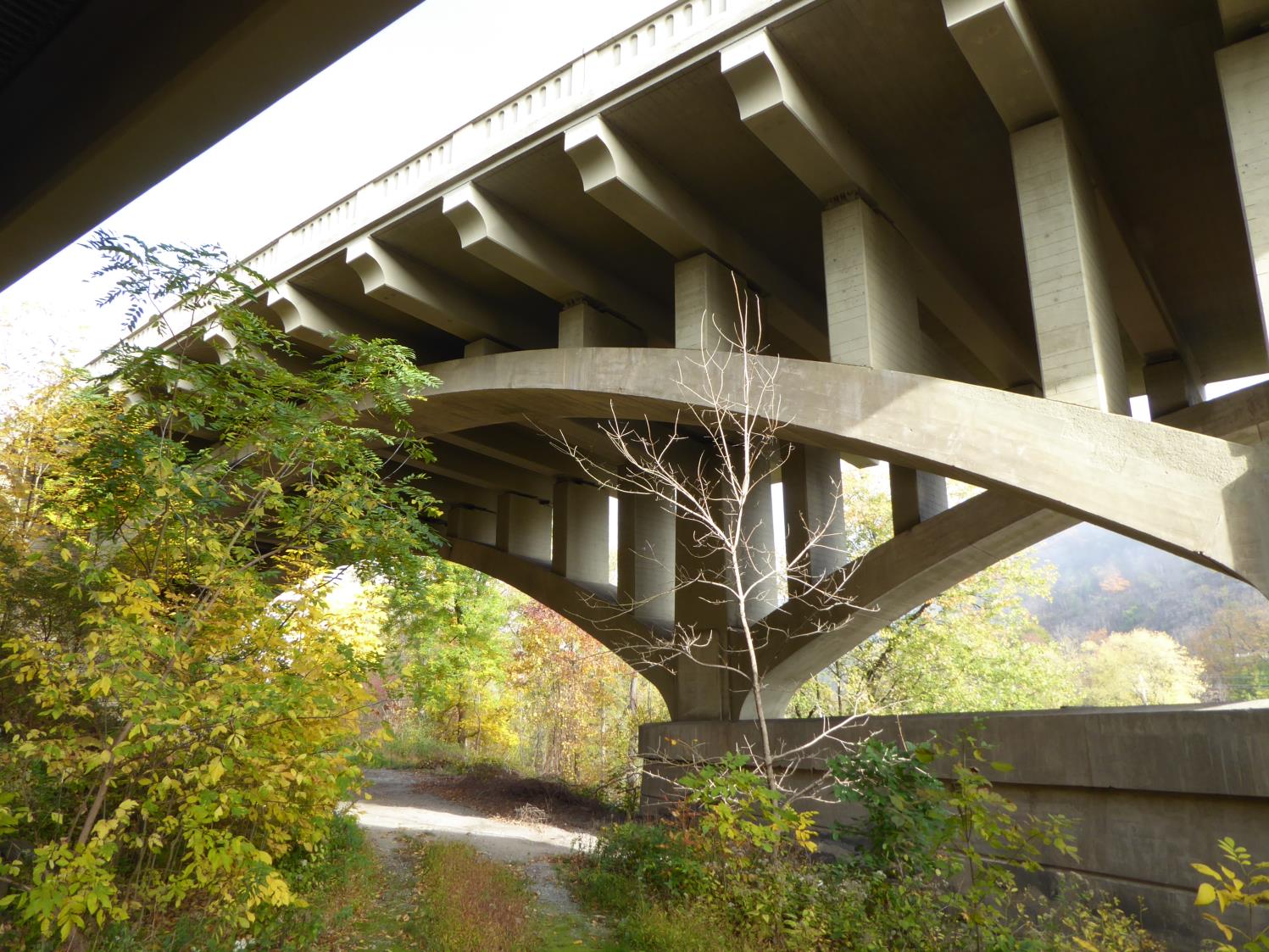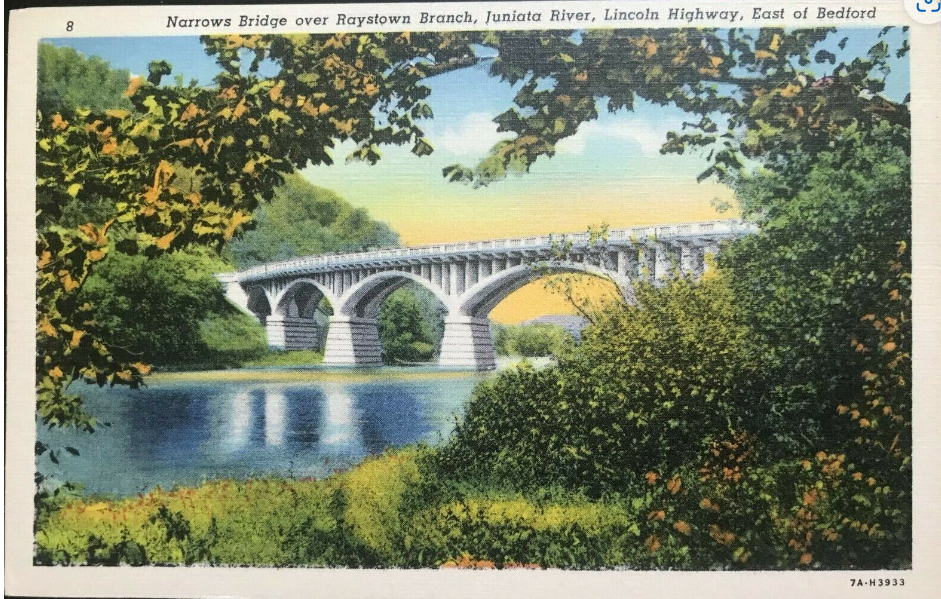Poking Around in Pennsylvania
Bedford County
Underneath the Narrows Bridge
by Craig Mains
Underneath the Narrows Bridge
by Craig Mains
About a mile east of Bedford both US Route 30 and the Pennsylvania Turnpike pass through a narrow gap in Evitts Mountain, a long ridge running in a southwest to northeast direction. The gap, referred to locally as “the Narrows,” is along the route Chain and I take to and from her workplace each day while we are in Bedford. I noticed that the Rt. 30 bridge over the Raystown Branch of the Juniata River in the Narrows looked interesting, so I thought I’d check it out a little closer. That turned out to be easier said than done.
One morning after dropping Chain off at work, I parked on the east side of the river and walked along Rt. 30 to a place where I could get a better view of the bridge---you really can’t see much of the bridge as you are going over it and you catch only a glimpse of it as you approach it from the east. I found a place where I could get a view of the bridge from the side, but that made me want to get a closer view the bridge, which meant getting underneath it.
A view of the Narrows bridge looking east. I could not get any closer from this side because just beyond the retaining wall, whose top is visible in the foreground there was a steep slope of loose rocks. I wasn’t sure I could get down it without getting injured or, if I did get down, whether I could get back up.
From previous poking around I had an idea where I might be able to get closer to the bridge. I saw on Google Earth that an old road along the east side of the river dead-ended almost directly under the bridge. Unfortunately, I found out the last half mile of the road was on private property and was heavily posted with No Trespassing signs. Only slightly discouraged, I continued to the end of the road where I ran into an older man who looked like he lived there in an RV. I asked for permission to cross his property to take some photos and he told me in no uncertain terms that I could not. Back to the drawing board.
A couple days later, after dropping Chain off at the hospital, I made another effort from the west side of the river. After scrambling down a couple steep slopes I found a trail that looked like it might have been an old railbed. It was grown up in tall grass that was still heavy with dew, so I was totally soaked from about mid-thigh to my feet in no time. Fortunately, in less than a mile the trail got me under the bridge where I was able to get some photos.
The trail I found on the west side of the river worked but was wet with heavy dew from the morning fog that was mostly gone. There was still dew on the spider webs.
The Narrows bridge from below. Mist was still rising off the river. The Narrows bridge was completed in 1935, which was during the time when steel-reinforced concrete structures were becoming more common. It is categorized as openspandrel arch bridge, with the open spandrel referring to the columns above the arches allowing for some open spaces, as opposed to a closed-spandrel bridge in which the sides of the bridge above the arches would be solid. Each of the five arches is 119 feet wide. The total length of the bridge is 599 feet. There are about 45 feet of clearance between the high point of the underside of the arches and the surface of the river.
In addition to some design elements that wouldn’t be included on modern bridges, the horizontal curve of the bridge as it crosses the river adds to its grace as well as the complexity of the engineering. Sometime after 1997 the bridge was rehabbed to address deterioration. Around the same time, this section of Rt. 30 was widened to four lanes and a second bridge was constructed next to the old one, shown here on the right. The newer bridge, not nearly as elegant, carries two lanes of east-bound traffic and the old bridge carries two lanes of west-bound traffic.
The horizontal bars above the arches that support the roadbed are reinforced inside with I-bars. The rounded notches in the ends of the bars are a nice touch.
The forms into which the concrete was poured to build the bridge were built onsite. Concrete was also mixed onsite as the bridge was built before the advent of redi-mix concrete delivery trucks.
Click/tap for a larger image
A vintage postcard view of the Narrows bridge. This view from the east side of the river, downstream of the bridge would not be possible today because the older bridge would be obscured by the new bridge.
The Narrows bridge is the sixth bridge over the river at this site. A hard surface road was completed between Harrisburg and Pittsburgh in 1818. Sections of the toll road were managed by private companies that collected tolls from travelers. The Chambersburg-Bedford Turnpike Company operated the section through the Narrows for almost a century and built the first five bridges, four of which were wooden.
A group of local farmers called the White Caps had a recurring history of conflict with the turnpike company. The White Caps, who mostly lived on the eastern side of the river, objected to being charged a toll every time they needed to go back and forth from town. At one point they built their own road that bypassed the bridge (presumably by fording the river) and the toll house. The turnpike company responded by moving the toll house. The fourth bridge was intentionally burned as an act of protest by a farmer, said to be acting on behalf of the White Caps. The turnpike company responded by building the fifth bridge out of iron.
In 1911, the state took over responsibility for maintaining roadways from private companies. In 1916, the road became part of the Lincoln Highway, which was promoted as the first coast-to-coast highway in the U.S.
October 2020






